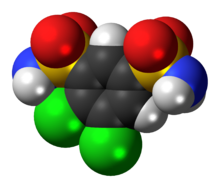 | |
 | |
| Clinical data | |
|---|---|
| AHFS/Drugs.com | International Drug Names |
| MedlinePlus | a601233 |
| ATC code | |
| Pharmacokinetic data | |
| Protein binding | 55% |
| Identifiers | |
IUPAC name
| |
| CAS Number | |
| PubChem CID | |
| IUPHAR/BPS | |
| DrugBank | |
| ChemSpider | |
| UNII | |
| KEGG | |
| ChEBI | |
| ChEMBL | |
| CompTox Dashboard (EPA) | |
| ECHA InfoCard | 100.004.037 |
| Chemical and physical data | |
| Formula | C6H6Cl2N2O4S2 |
| Molar mass | 305.14 g·mol |
| 3D model (JSmol) | |
| Melting point | 228.5 °C (443.3 °F) |
SMILES
| |
InChI
| |
| (what is this?) (verify) | |
Diclofenamide (or dichlorphenamide) is a sulfonamide and a carbonic anhydrase inhibitor of the meta-disulfamoylbenzene class. Dichlorphenamide as a carbonic anhydrase inhibitor is used for the treatment of acute angle closure glaucoma. While Dichlorphenamide does contain two sulfate groups within the structure, it falls under the class of a first generation carbonic anhydrase Inhibitor.
Uses
Diclofenamide was approved in the United States in 1958 as Daranide to treat glaucoma, Subsequently, it was found effective in cases of therapy-resistant epilepsy. In 2015, the medication was approved in the US under the name Keveyis as an orphan drug for the treatment of primary hypokalemic and hyperkalemic periodic paralysis.
Cost
In 2001, diclofenamide had a U.S. list price of $50 for a bottle of 100 pills, and was approved for glaucoma. Merck discontinued diclofenamide when better glaucoma drugs were developed. In 2010, Sun Pharmaceutical Industries bought the rights. In 2015, the F.D.A. approved it as an orphan drug, with 7-year exclusive marketing rights, for periodic paralysis, which the company estimates affects 5,000 people in the U.S. In 2016, Strongbridge Biopharma acquired Sun, which raised the price to $15,001 for 100 pills. The cost of treatment would range from $109,500 to $219,000 a year. Sun gives the drug free to patients who don't have insurance.
References
- ^ "Dichlorphenaide (Keveyis) for Periodic Paralysis". The Medical Letter. April 16, 2016. Retrieved December 19, 2017.
- International Drug Names: Diclofenamide
- Kanski JJ (August 1968). "Carbonic anhydrase inhibitors and osmotic agents in glaucoma. Carbonic anhydrase inhibitors". The British Journal of Ophthalmology. 52 (8): 642–3. doi:10.1136/bjo.52.8.642. PMC 506660. PMID 5724852.
- Rucquoy M, Sorel L (1978). "Diclofenamide in the treatment of therapy-resistant epilepsy". Acta Neurologica Belgica. 78 (3): 174–82. PMID 352085.
- ^ Johnson CY (December 18, 2017). "This old drug was free. Now it's $109,500 a year". Washington Post.
| Drugs used for glaucoma preparations and miosis (S01E) | |||||||
|---|---|---|---|---|---|---|---|
| Sympathomimetics | |||||||
| Parasympathomimetics |
| ||||||
| Carbonic anhydrase inhibitors/ (sulfonamides) | |||||||
| Beta blocking agents | |||||||
| Prostaglandin analogues (F2α) | |||||||
| Other agents | |||||||
This antihypertensive-related article is a stub. You can help Misplaced Pages by expanding it. |